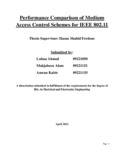| dc.contributor.advisor | Ferdous, Hasan Shahid | |
| dc.contributor.author | Ahmed, Lubna | |
| dc.contributor.author | Alam, Mahjabeen | |
| dc.contributor.author | Kabir, Amran | |
| dc.date.accessioned | 2012-05-30T06:30:56Z | |
| dc.date.available | 2012-05-30T06:30:56Z | |
| dc.date.copyright | 2012 | |
| dc.date.issued | 2012-04 | |
| dc.identifier.other | ID 09221050 | |
| dc.identifier.other | ID 09221121 | |
| dc.identifier.other | ID 09221133 | |
| dc.identifier.uri | http://hdl.handle.net/10361/1843 | |
| dc.description | This thesis report is submitted in partial fulfillment of the requirements for the degree of Bachelor of Science in Electrical and Electronic Engineering, 2012. | en_US |
| dc.description | Cataloged from PDF version of thesis report. | |
| dc.description | Includes bibliographical references (page 49-51). | |
| dc.description.abstract | IEEE 802.11 specifies a set of protocols for a wireless LAN defined by IEEE which covers the physical and data link layer. Nowadays, IEEE 802.11 based WLAN has a widespread and ubiquitous use in providing wireless connectivity to several electronic devices like cell phones, laptops, gaming devices and so on. All these devices operate on the same medium and contend with each other in order to access the medium. All devices using the IEEE 802.11 Standard adopt a basic MAC scheme called the distributed coordination function (DCF) whose key function is contention resolution. The Binary Exponential Backoff (BEB) scheme is used to access the medium and deliver packets over a wireless network. However, the performance and efficiency of IEEE 802.11 DCF scheme is a matter of question as the number of contending stations are increasing everyday. In this paper we make a detailed study of the performance comparison between DCF, CONTI, k-EC and PREMA, which are various contention resolution schemes proposed in various independent researches. The criteria for performance comparison that we will use are collision rate, throughput and average delay between successful transmissions. Also, in this paper we are going to propose an unsaturated model for the contention schemes whose implementation and performance is consistent with the saturated mode used in the above contention schemes. Furthermore, we compare the performance for each of the contention resolution schemes in the unsaturated mode. | en_US |
| dc.description.statementofresponsibility | Lubna Ahmed | |
| dc.description.statementofresponsibility | Mahjabeen Alam | |
| dc.description.statementofresponsibility | Amran Kabir | |
| dc.format.extent | 51 pages | |
| dc.language.iso | en | |
| dc.publisher | BRAC University | en_US |
| dc.rights | BRAC University thesis are protected by copyright. They may be viewed from this source for any purpose, but reproduction or distribution in any format is prohibited without written permission. | |
| dc.subject | Electrical and electronic engineering | |
| dc.title | Performance comparison of medium access control schemes for IEEE 802.11 | en_US |
| dc.type | Thesis | en_US |
| dc.contributor.department | Department of Electrical and Electronic Engineering, BRAC University | |
| dc.description.degree | B. Electrical and Electronic Engineering | |

